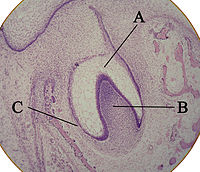
Photo from wikipedia
Human dental follicle cells (DFCs) as periodontal progenitor cells are used for studies and research in regenerative medicine and not only in dentistry. Even if innovative regenerative therapies in medicine… Click to show full abstract
Human dental follicle cells (DFCs) as periodontal progenitor cells are used for studies and research in regenerative medicine and not only in dentistry. Even if innovative regenerative therapies in medicine are often considered the main research area for dental stem cells, these cells are also very useful in basic research and here, for example, for the elucidation of molecular processes in the differentiation into mineralizing cells. This article summarizes the molecular mechanisms driving osteogenic differentiation of DFCs. The positive feedback loop of bone morphogenetic protein (BMP) 2 and homeobox protein DLX3 and a signaling pathway associated with protein kinase B (AKT) and protein kinase C (PKC) are presented and further insights related to other signaling pathways such as the WNT signaling pathway are explained. Subsequently, some works are presented that have investigated epigenetic modifications and non-coding ncRNAs and their connection with the osteogenic differentiation of DFCs. In addition, studies are presented that have shown the influence of extracellular matrix molecules or fundamental biological processes such as cellular senescence on osteogenic differentiation. The putative role of factors associated with inflammatory processes, such as interleukin 8, in osteogenic differentiation is also briefly discussed. This article summarizes the most important insights into the mechanisms of osteogenic differentiation in DFCs and is intended to be a small help in the direction of new research projects in this area.
Journal Title: International Journal of Molecular Sciences
Year Published: 2022
Link to full text (if available)
Share on Social Media: Sign Up to like & get
recommendations!